According to the conductor Alvaro Cassuto: "His music can be viewed mainly
as a fusion of European styles, particularly that of Western Europe. His
unique gifts demonstrate themselves by the fact that the first four symphonies
came between the age of 22 and 27, and were immediately performed by the
Portuguese Radio Symphony."
At the age of 29 he studied conducting with Hermann Scherchen in Austria
and it was as a conductor that he made his way in the world. Conducting took
over his life to such an extent that composition largely ceased. In 1965
he returned to the creative art with the Fifth Symphony and a new idiom which
was positively modern largely leaving behind the accessible and life-enhancing
style of the first four symphonies.
Rob Barnett
JOLY BRAGA SANTOS
(1924-1988) Symphony No. 3 (1948)
 London SO/Alvaro
Cassuto London SO/Alvaro
Cassuto  recorded Henry Wood Hall, 10 June 1986 PORTUGALSOM SP4182 [38:57]
recorded Henry Wood Hall, 10 June 1986 PORTUGALSOM SP4182 [38:57]
How to order this CD |
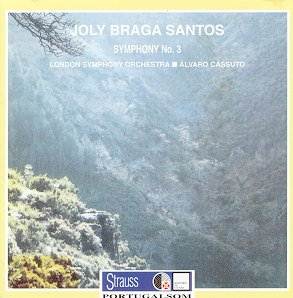
Cassuto occupies in relation to Braga Santos a reputation proximate to Vernon
Handley in relation to Arnold Bax; not that the music of the two composers
is similar. Cassuto has succeeded Silva Pereira as his champion both on the
podium and in his writings.
Cassuto's Marco Polo cycle progresses slowly with four of the six symphonies
already available and reviewed by the present reviewer.
The Third Symphony dates from the composer's gloriously melodic phase; the
same stock as the Fourth Symphony.
As I have written previously the third symphony is an essentially melodic
work which seems to me to breathe the salty Atlantic air and sea-spume. The
music strikingly parallels the livelier parts of Moeran's G minor symphony
(1937), of Vaughan Williams Symphonies 5 and 6 and of Kodaly's Symphony.
There is a hint of Respighi's Church Windows and Concerto Gregoriano
too.
The second movement's mysterious lento resounds initially to the ppp
tolling of the tam-tam stroke (recalling Gösta Nystroem's Sinfonia
Del Mare - I WILL get that work better known!) but soon asserts itself
as a vehicle for a silkily luminescent string-led theme uncannily like one
of Bernard Herrmann's blonde heroine/anti-heroine themes. The following
Tempo di scherzo is astonishingly similar to the Moeran
Sinfonietta and Serenade. Here and there you get touches of
Sibelius's Tapiola, more Biblical epic style Respighi and rustic dances.
The finale is inaugurated by a monastically subdued adagio shifting easily
into a ppp 'Pilgrim's March' for sweet high strings (just a twist
of dissonance here) rising to a statement of dramatically swung eminence.
The fugal fracas that follows does not impress but soon we are back to the
alert straining at the leash of the scherzo and a (not altogether conclusion
that synthesises the Great Gate of Kiev and the crashing finale of
Sibelius's Second Symphony. If you start with this symphony, and like it,
don't forget to move on to the Fourth Symphony.
The orchestra is in fine fettle and the technical aspects are handled with
consummate skill by two very familiar names: John Boyden and Tony Faulkner.
The recording is the only fully digital (DDD) recording in the present small
collection of Portugalsom discs.
The Sixth Symphony with which the Third is coupled on Marco Polo is arduous-going
so if you want to restrict yourself to exploring the inimitably tuneful Braga
Santos this is the disc for you and at modest price! Of course playing time
is short but the music is well worth your attention.
Reviewer
Robert Barnett

JOLY BRAGA SANTOS
(1924-1988) Symphony No. 4 in e minor (1949)
 'George Enescu'
Choir Roumanian Radiotelevision SO/Silva
Pereira 'George Enescu'
Choir Roumanian Radiotelevision SO/Silva
Pereira  recorded Bucharest, November 1978 STRAUSS PORTUGALSOM SP4059 [47:31]
recorded Bucharest, November 1978 STRAUSS PORTUGALSOM SP4059 [47:31]
How to order this CD |
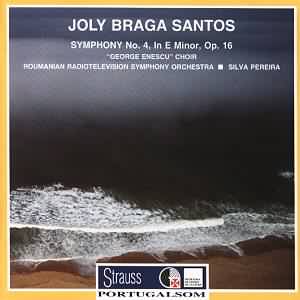
You must hear this symphony - a positive and life-endorsing hymn to joy.
But first some words of biographical introduction.
The present symphony is in four movements the first of which (lento - allegro
con fuoco) is orchestrally stunning, blending the voices of Vaughan Williams
(a very positive and recurrent influence), Bruckner (especially No. 4 in
the opening 3 minutes), Hanson and even Frank Bridge's The Sea. The
tranquil andante rises in a torment of string writing to a climax that takes
something from Rózsa's ultra-romantic music for El Cid and
RVW's Tallis Fantasia. The climax is one of towering and tolling power.
The third movement offers, among many attractions, mellifluous harp runs,
piercing trumpet calls, an impressionist melos recalling Debussy's La
Mer and a winding and insistent beauty of a folk-tune. The finale is
absolutely glorious with chattering trumpets (the Roumanian orchestra's players
clearly challenged by what they are called on to do), Sibelian woodwind,
a contrasting theme which sounds as if it might belong in the finale of
Rachmaninov's Symphony No. 1, a punchy woodwind rhythmical figure that sounds
uncannily like the start of Moeran's G minor symphony and occasionally rather
like the much underestimated symphony by Kodaly. I also remembered the
4th symphony of Bohuslav Martinu, especially in its closing pages.
There is a naïve but intoxicating hymn sung in fervent Russian style
by the Roumanian choir. The singing closes the piece in a dazed and dazzling
gaze into the perpetual sunrise of youth.
Notes are by Maria Helena de Freitas and are in Portuguese and English. The
text of the brief paean to youth is printed in both Portuguese and English
although (sadly) not side by side.
Anyone at all warming to the works of Howard Hanson, Randall Thomson, Douglas
Lilburn, Vaughan Williams or George Lloyd must hear this CD.
In terms of playing time a disc running just over three-quarters of an hour
may seem of contentious value. Be reassured; this is a gorgeous symphony.
Once heard, it will lurk in your 'singing in the bath' repertoire and flood
back from your memory from time to time leaving you puzzled (and affronted)
as to why it is not played in concert halls and on radio stations around
the world.
The strongest recommendation.
Reviewer
Rob Barnett

see also review by Richard Adams
JOLY BRAGA SANTOS
(1924-1988) Symphony No. 5 Virtus Lusitaniae
(1965-66)
 RDP SO/Silva
Pereira RDP SO/Silva
Pereira  recorded Bucharest, November 1978 STRAUSS PORTUGALSOM SP4059 [47:31]
recorded Bucharest, November 1978 STRAUSS PORTUGALSOM SP4059 [47:31]
How to order this CD |
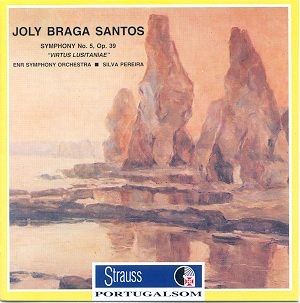
This is a symphony heavy with doom-laden foreboding. It opens with an insistent
heartbeat close to the sound of a ticking clock (the enemy of the heartbeat).
The music has a straining avant-garde lyricism familiar from the contemporaneous
Three Symphonic Sketches. This style is also familiar from the music
of Karl Amadeus Hartmann, Roberto Gerhard and perhaps Matthijs Vermeulen
though without Vermeulen's ecstatic dazzle.
Nevertheless this work has some, more than promising, imaginative coups e.g.
the upward-striking waves of violin-articulated agony (5.49 in track 1).
It is worth emphasising that this work is utterly divorced in style from
the easier tonality of the immediately accessible fourth symphony (1950).
In terms of recording quality this disc is the best sounding of the four
reviewed here although it is the oldest recording. It is not that any of
the discs sound poor but this one provides a satisfyingly rich sound under
considerable pressure from an occasionally very loud orchestra.
The other highlights include the spoken 'wailing' of the brass at 2.00 in
the second movement. In the Largo those imperceptibly shifting, quiet,
high-whistling violins with marimbas and exotic percussion remind one of
Malcolm Arnold (fourth symphony). This music though has little of Arnold's
wondering lyricism unless you look to the tougher Arnold symphonies - numbers
7 and 9. Much of the music is oppressive: 'centuries in the chasm' rather
than 'paradisal visions'. The last movement has Arnoldian percussion and
brass (reminiscent of Arnold Symphonies 4-6) and the more demonstrative Andrzej
Panufnik (Tragic Overture and central movement of the Sinfonia
Elegiaca).
Notes (Portuguese and English) are important as they are by the composer
and although they touch on some musicological matters they are, overall,
informative and enjoyable to read.
Recommended for those with mildly stiffened sinews! If you enjoy late Rawsthorne,
William Schuman, Panufnik, Hartmann and Vermeulen you must hear this symphony.
The disc is inexpensive. The only competition is on Marco Polo where Symphonies
Nos. 1 and 5 are played by the Portuguese Symphony Orchestra conducted in
a 1990s recording by Álvaro Cassuto. That disc is Marco Polo 8.223879
however while clearly eager and committed that performance does not have
the sense of special occasion of this Portugalsom disc.
Reviewer
Rob Barnett

JOLY BRAGA SANTOS
(1924-1988) Sinfonietta for string orchestra (1963)
Concerto in D for string orchestra (1951)
 Budapest PO/Andras
Korodi Budapest PO/Andras
Korodi  rec Hungaroton Studios, Budapest 1986 supervised by the composer STRAUSS
PORTUGALSOM CD870017 [ 36.00]
rec Hungaroton Studios, Budapest 1986 supervised by the composer STRAUSS
PORTUGALSOM CD870017 [ 36.00]
How to order this CD |
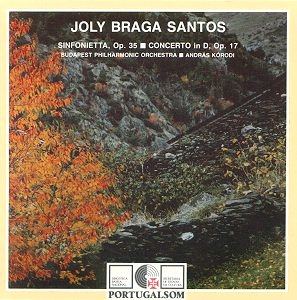
Joly Braga Santos is much more likely to be known to the moderately well
informed music lover than was once the case. The issue of two Marco Polo
CDs of all but two of the six symphonies has, up to a point, put this composer
'on the map'.
The present discs will be of particular interest to those who have invested
in those Marco Polo CDs and would like to excavate further.
The Sinfonietta can loosely be bracketed with Bliss's Music for
Strings, Tippett's Corelli Fantasia and William Alwyn's
Sinfonietta for Strings. The Hungarians make a beefy 'big band' sound;
nothing gaunt about the textures. There is a yieldingly Bergian adagio
(the Alwyn work is certainly a good parallel) and a spiky allegro ben
marcato ending in a delirious Rozsa-like dance.
The Concerto in D's largamente is, again, reminiscent of Rózsa:
so approachable and exuding a quiet confidence against the storm. Howells'
Concerto for Strings is a further reference. Notable is the song of the first
movement, sung sweetly by solo violin.
The central adagio is extremely tuneful and introspective. The finale
has the innocent dancing air of a summer morning - a Capriolic frolic as
it were - but with more heart than the sometimes self-conscious jolly archaism
of the Warlock work.
The notes (by Joao Paes) are in Portuguese and English. Their accent is on
musicological analysis. Sadly this hardly ever reads attractively. Details
such as the premiere and any dedication do not appear.
These two string works are not at all hard work. Well worth the modest price.
Reviewer
Rob Barnett

JOLY BRAGA SANTOS
(1924-1988) Divertimento No. 1 for orchestra (1961)
[21.15] Viola Concerto (1963) [26.05]
 Ana Bela Chaves
(viola) Budapest PO/Andra Korodi Ana Bela Chaves
(viola) Budapest PO/Andra Korodi
 Hungaroton
Studios, Budapest 16-19 March 1981 supervised by the composer STRAUSS
PORTUGALSOM CD870008 [47.55] Hungaroton
Studios, Budapest 16-19 March 1981 supervised by the composer STRAUSS
PORTUGALSOM CD870008 [47.55]
How to order this CD |
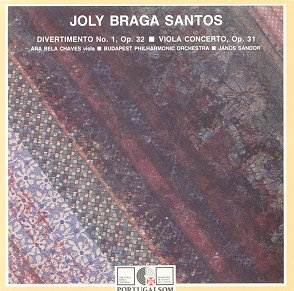
The Divertimento No. 1 is in three movements. The preludio has an
auburn quality and is much taken up with energetic outbursts and tension
barely contained. The feria operates as an intermezzo - bubbling,
crisp, sour trumpets, Shostakovichian woodwind. The sweeping charming of
the woodwind's long-breathed song at 3.48 is a highlight. The jollity of
the finale is part Mediterranean sun and part Atlantic spume.
The Concerto is morose, at first, but rises above depression at 5.20 in a
joyous outburst. Folk-like 'pipe and tabor' passages suggest Canteloube (6.10).
After other episodes that cannot help reminding one of Vaughan Williams Flos
Campi the first movement plays out against overcast ominous bottle-black
skies. The energico (only 5 mins duration) once more has the mien
of quiet confidence and a folksong heredity. The allegro lamentoso is
much taken with shade though there are some moments when the naturally lyric
talent of the much derided 'alto singer' is allowed to run free. All in all
though I think of this movement in terms of how a late viola concerto by
Frank Bridge might have sounded had he written one although the lucid beauty
and blue skies climax (8.42) is very different from Bridge's world of owls
and lichen. Nevertheless the piece plays out quietly - emotionally equivocal.
Good notes this time including useful background on the composer and touching
briefly on the musical technicalities.
A worthwhile and attractive issue.
Reviewer
Rob Barnett

Score and parts available from Santos Beirao, R Candido Figueiredo 87-D -
1500 Lisboa, Portugal
JOLY BRAGA SANTOS
(1924-1988) Three Symphonic Sketches (1961) [10.16]
Elegy to Vianna da Motta (1948) [9.15] Symphonic Variations
on a Theme from Alentejo (1951) [14.13]
 RDP SO/Alvaro Cassuto RDP SO/Alvaro Cassuto
 Hungaroton
Studios, Budapest 10-15 October 1978 technical and musical assistance/supervision
by the composer STRAUSS PORTUGALSOM SP4055 [33.51] Hungaroton
Studios, Budapest 10-15 October 1978 technical and musical assistance/supervision
by the composer STRAUSS PORTUGALSOM SP4055 [33.51]
How to order this CD |
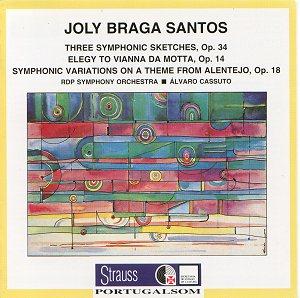
The Three Sketches are astringent: a difficult piece though not without
a strained brand of lyricism. By contrast the Vianna da Motta Elegy
(note the comparative review of the Vianna da Motta symphony in the February
2000 reviews) is dignified and has more of the easily accessible lyricism
of the composer's early period.
The Alentejo Variations are also extremely accessible (as are Luis
de Freitas Branco's two Alentejana suites): goatbells, more of the
mountainside 'pipe and tabor', jaunty folksiness. All these place the work
alongside Braga Santos's irresistible and world-class fourth symphony. Just
think of a vivid hybrid between the Moeran Symphony and Falla's El Amor Brujo
and there you have these Variations. The Alentejo Variations must
have gone down well in Brittany where they were premiered.
All the works are lovingly done by Alvaro Cassuto. The playing is completely
committed but the Portuguese trumpets are tested to and beyond the limit
at the close of the Variations.
This is easily the most rewardingly listenable of these four Braga Santos
discs.
Reviewer
Rob Barnett

MOZART
Piano Concerto No. 21 rec 1961
JOLY BRAGA SANTOS Symphony No.
1 rec 1960  Portuguese National SO/Pedro de Freitas Branco
Portuguese National SO/Pedro de Freitas Branco
 STRAUSS
PORTUGALSOM SP4055 [60.57] STRAUSS
PORTUGALSOM SP4055 [60.57]
How to order this CD |
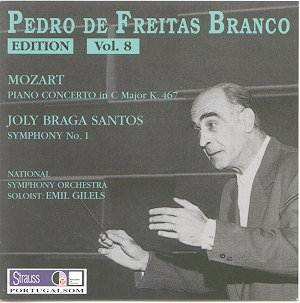
This conductor-centric disc is part of a series of 12 discs (you can buy
all of them at a special price) preserving a selection of the RDP (Radiodifusao
Portuguesa) broadcasts of his live and studio concerts.
De Freitas Branco (born in 1896 and not to be confused with the composer
Luis de Freitas Branco) gave his first concert in Lisbon on 12 December 1926
at the age of thirty and his last, in Lisbon, on 16 December 1961. During
the mid-1920s he conducted in London for two years before returning to Lisbon,
forming the Lisbon SO and being appointed to the National SO in 1934. In
Lisbon he premiered, amongst a multitude of other works, Berlioz's Romeo
and Juliet, Strauss's Also Sprach Zarathustra and Stravinsky's
Rite of Spring.
The Concerto is pearlescent and joyously alert. Gilels specialists will want
to track down this rare disc.
My main interest is in the Braga Santos First Symphony. This has now been
recorded by Marco Polo and in much better sound. It is dedicated to the heroes
and martyrs of the Second World War. The Molto Sostenuto is a resignedly
heroic trudge smacking of some Oriental procession - though a very quiet
one. The second half of the movement (allegro moderato) is snappy, flame-licking
and militaristic like Vaughan Williams film music of the 1940s. The strings
are not of high quality and once or twice the strain shows through (e.g.
12.15 in I) but there is no mistaking the bubbling passion of the performance.
After an andante of slowly paced but intense conflict there follows a troubled
allegro assai ruffled with Slav cross-currents (Borodin). The engineers
noticeably (and damagingly) pull back on the volume levels towards the end.
Each of the De Freitas Branco Edition discs is available to buy separately
but there is a special price for the complete set.
Historically important but really more for the specialist's specialist.
Reviewer
Rob Barnett

THE TWO MARCO POLO DISCS:-
JOLY BRAGA SANTOS
(1924-1988) Symphony No 3 (1949) [38:57]
Symphony No 6 (1972) 26:04 *
 * Ana Ester Neves
(sop) * Chorus of Teatro Nacional de Sao Carlos/Joao Paulo Santos
Portuguese SO/Alvaro
Cassuto * Ana Ester Neves
(sop) * Chorus of Teatro Nacional de Sao Carlos/Joao Paulo Santos
Portuguese SO/Alvaro
Cassuto  recorded September 1997 MARCO POLO 8.225087 [65:11]
recorded September 1997 MARCO POLO 8.225087 [65:11]
How to order this CD |
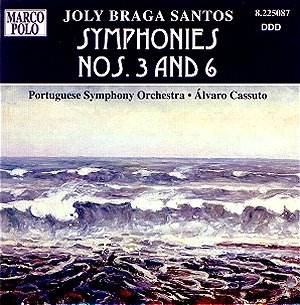
I have wanted to hear more of the music of this Portuguese composer ever
since encountering his impressive and melodiously approachable Symphony No
4 in a performance incongruously given, not by a Portuguese orchestra, but
by the Romanian Radio SO. This work, which also includes choral parts, is
not at all blandly tuneful but is quite striking in its approach while at
the same time sporting memorable themes.
When I reviewed the Marco Polo disc of Braga Santos's Symphonies 1 and 5
the contrast in style between the two works is striking. Something similar
happens here. The third symphony is an essentially melodic work whereas the
single movement sixth is often dissonant. At least we now know that the next
disc, which must surely couple symphonies 2 and 4, will contain two works
which will be wholly melodic and completely approachable. The second symphony
is a complete unknown.
The Third Symphony seems to breathe the sea air. After all Portugal is a
great maritime nation which numbers many explorers amongst their great men.
For years they have been dependent on fishing for their economy. The symphony
lays no claims to being a maritime symphony but I give my impression exactly
as it came to me on hearing the music.
The first movement opens with a subdued three minute prelude. A hieratic
marine trumpet ushers in a pregnant tension from quavering violins which
relax into a bright-eyed hustling Moeran-like scherzo complete with flute,
oboe, harp and side-drum. The remainder of the movement is demonstrative
and vigorous in a very open-air spirit. It ends with a splash of side-drum
blows.
The second movement is a big lento. It starts again with a mystery paralleling
that of the first movement. Both Copland and Hovhaness are evoked; the latter
with a persistent tam-tam stroke. This is very romantic stuff without being
sloppy. It reminded me of quite a few John Barry film scores listen to 8:24
on track 2. There are recollections too of Bernard Herrmann (The Trouble
With Harry), Shostakovich and Nystroem - that gong again.
The third movement, tempo di scherzo is frighteningly like the brilliant
Moeran - specifically his Sinfonietta with a lashing of Vaughan Williams
in maritime mode, rural Rózsa (peasant song variations) and some
Galanta Kodaly. Harp, side-drum, bass drum, pizzicato it is all there.
Sometimes we move towards the Moeran of Serenade. I wonder if Santos
knew Moeran's music.
The finale is marked adagio - allegro. VW haunts its opening pages in an
ever-shifting quietly reverential style for the strings and then through
whispering woodwind. By gradual progress we move towards a more martial
atmosphere though it is still heavily folk-styled and remarkably like Vaughan
Williams' middle and late period music for massed strings (Concerto Grosso
and Partita). A bass drum-beat provides a counterpoint for a noble
Copland-like tune which reaches higher and upwards until it melts into a
priest-like oration-chorale for brass with gong and cymbals. Braga Santos
does not bring off the finale entirely successfully but it remains a satisfying
rounding off to an extremely attractive symphony.
The Sixth Symphony is a strange construct. The first half of it is a work
of echoes, creeping and wallowing strings, drums, bells and clashing tonality.
It has much in common with the language of the fifth symphony, only breaking
free when the composer decides to include a vocal setting. Although in a
single continuous movement the segments of the work are given six bands.
Two are folk-like approachable settings for solo soprano, chorus and orchestra
of two poems by the sixteenth century Portuguese poet, Luis de Camoes. The
last of these, predominantly for solo soprano, is a gem of a setting, reminding
me of Elisabeth Soderstrom's unforgettable soprano solos in Nystroem's
Sinfonia del Mare (1949). The soprano has a voice of fine and firm
tone. Both poems are printed in the booklet in the original language with
English translation.
The extensive and seminally informative notes (English, German, French -
no Portuguese!) are by the conductor.
The cover is a picture of waves breaking on a shore. The picture is by Falcao
Trigoso.
Recommended for those willing to venture out into deeper waters. Be ready
to make new friends. If you enjoy Guridi, Moeran, RVW or Kodaly you owe it
to yourself to try these works. Thank you Marco Polo. More please.
Reviewer
Robert Barnett

JOLY BRAGA SANTOS
(1924-1988) Symphony No 1 (1946) [36:19]
Symphony No 5 Virtus Lusitaniae (1965-66) [30:59]
 Portuguese SO/Alvaro
Cassuto Portuguese SO/Alvaro
Cassuto  MARCO POLO 8.223879 [67:16]
MARCO POLO 8.223879 [67:16]
How to order this CD |
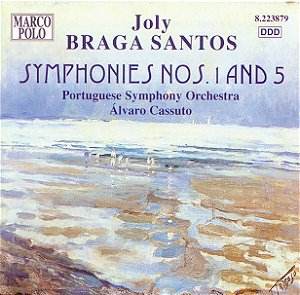
There is a fairly wide stylistic gulf between the two very decently recorded
works on this disc. The first symphony (3 movements) steps out into Vaughan
Williams territory; something mentioned in the sleeve notes. This is the
Vaughan Williams of Symphonies 4-6 and especially the latter. What is not
mentioned is that the energetic galloping music reminds me very strongly
of Eduard Tubin and his fourth symphony. It is in four movements and the
whole work is dedicated to 'To the memory of the Heroes and Martyrs of the
last World War."
Symphony No 5 (4 movements) is written in a very different argot. The music
has drawn on the same indicators as William Schuman and Alan Rawsthorne.
Portugal's imperial heritage is recalled in the presence of a large percussion
section and in the title which is a reference to the Roman name for Portugal:
Virtus Lusitaniae. The composer visited Portuguese Mozambique during the
early 60s and reflected some of the rhythms and tunes of popular African
music in the symphony. The work has much foreboding despite what one expects
to be carefree influences. Brass blares enigmatically; drums thud and strings
conjure wisps of sound. Perhaps Santos recognised the troubles of Mozambique
during the struggle for independence from Portugal and the turmoil that followed.
Certainly this is not comforting or comfortable music. We should not expect
soft-toned music written in an era of colossal social upheaval and with the
spectre of nuclear conflict still present alongside memories of Cuba. The
last movement explodes into action with a barrage of drumming but drifts
into a more serene landscape. The impressive brass writing occasionally hints
that Santos may have heard the symphonies of Robert Simpson - not that many
of them had been written by 1966. The piece ends in an acidic blaze of colour.
The divide in style between these two works rather suggests that those who
prefer the laid-back though commanding style of the first symphony should
be ready to hear symphonies 2 and 3. Number 4 I can already testify to as
a work you will enjoy if you like Tubin, Holmboe, RVW or George Lloyd. I
hope that Marco Polo will not stop there. Having heard both symphonies 3
or 4 times now I am not sure how convincing the fifth symphony is.
Recommended for the adventurous - they will be rewarded not disappointed.
Be warned though that the two symphonies are written in such different styles.
The useful booklet notes are again by conductor Alvaro Cassuto.
Reviewer
Rob Barnett

Ordering details
for PORTUGALSOM
The prices are: UK pounds- 6 and US dollars -10 (freight not included).
The transport costs are :
For UK----- 1 or 2 CDs ------UK£1.60; 3 CDs ----£2.5
For USA---- 1 or 2 CDs-----US$3.50 ; 3 CDs --- $5.5
Orders can come by fax to fax number 351 1 7141723,
by e-mail to:strauss@mail.telepac.pt
or by mail for attention Eduarda Martins to the address:
Strauss, S.A.
Rua Adelaide Cabete, 3C,
1500-023 LISBOA
Portugal.
Credit cards are accepted with the name of the buyer, credit card number,
validity date and type of card.
orch score and parts available from Sociedade Portuguesa de Auotores
Av Duque de Loule 31
1000 Lisboa
Portugal
Orders and enquiries for this disc to
Strauss S.A.
Rua Adelaide Cabete 3-C
1500 Lisboa
Portugal
phone 01 7151151 - 7143490
fax 01 7141723
